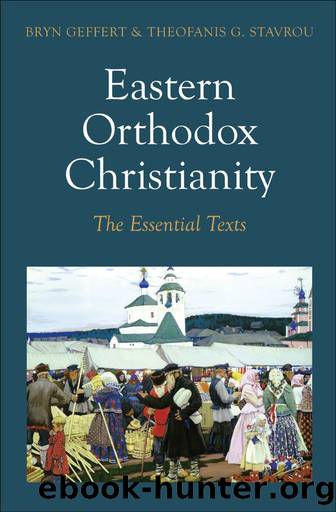Eastern Orthodox Christianity: The Essential Texts by Bryn Geffert & Theofanis G. Stavrou

Author:Bryn Geffert & Theofanis G. Stavrou [Geffert, Bryn]
Language: eng
Format: azw
Publisher: Yale University Press
Published: 2016-05-28T00:00:00+00:00
Great Schism
The 400s to the 1200s witnessed a progressive, albeit gradual, estrangement between churches in the East and churches in the West, marked by crises both big and small as well as by attempts at reconciliationâsome successful and some not. Thousands of books and articles have tried to explain the schism. Scholars disagree on particulars, but nearly all agree that the causes were numerous. Divergent explanations and interpretations differ mainly in the relative import granted to each.
Kallistos Ware, the author of a popular history of the Eastern Orthodox Church, rightly notes that âlong before there was an open and formal schism between East and West, the two sides had become strangers to one another.â1 The questions are why and how did members of the same faith become strangers?
Distance, certainly, played an important role. Constantinople sits nearly fourteen hundred kilometers east of Rome as the crow flies and twenty-two hundred kilometers by boat: south toward Sicily, east across the Mediterranean Sea, northeast around the Greek peninsula, up through the Aegean Sea, and east across the Sea of Marmara. Communications moved slowly, with difficulty, and infrequently. Travel was dangerous: as noted above, pirates kidnapped Gregory Palamas during a trip to Constantinople.
Although the Roman Empire remained in theory one empire throughout its history, it had begun to function as two different empires by the end of the 200s, each ruled by a co-emperor. (Recall that Constantine served as co-emperor with Licinius before claiming the throne exclusively for himself.) Constantineâs relocation of the capital city to Constantinople only exacerbated divisions. After Constantine died, an alternating series of dual and single emperors followed. The last member of Constantineâs family line, Theodosius I (379â395), proved to be the last emperor to rule a unified empire.
Download
This site does not store any files on its server. We only index and link to content provided by other sites. Please contact the content providers to delete copyright contents if any and email us, we'll remove relevant links or contents immediately.
| Amish | Catholicism |
| Christian Science | Jehovah's Witness |
| Mennonite | Messianic Judaism |
| Mormonism | Orthodoxy |
| Protestantism |
Under the Banner of Heaven: A Story of Violent Faith by Jon Krakauer(1417)
The Early Centuries - Byzantium 01 by John Julius Norwich(1364)
Taken by J. C. Owens(1282)
In Spirit and Truth (In Spiritu Et Veritate Series) by Reed Zoe(1265)
The Amish by Steven M. Nolt(1254)
Play It as It Lays by Joan Didion(1212)
The Apogee - Byzantium 02 by John Julius Norwich(1162)
The Last Man in Russia by Oliver Bullough(1102)
A History of the Amish by Steven M. Nolt(984)
Tears of the Silenced: A True Crime and an American Tragedy; Severe Child Abuse and Leaving the Amish by Misty Griffin(963)
Leaving the Witness by Amber Scorah(951)
Fallen by unknow(930)
David Sedaris Diaries by David Sedaris(921)
The Angel of Forest Hill by Cindy Woodsmall(901)
The Best of Amish Cooking by Phyllis Pellman Good(884)
The Ariana Trilogy by Rachel Ann Nunes(881)
Escape by Carolyn Jessop & Laura Palmer(878)
Deep Blue by unknow(872)
Primal: A Quest for the Lost Soul of Christianity by Mark Batterson(858)
